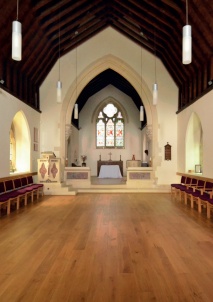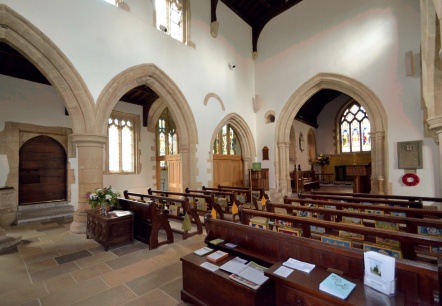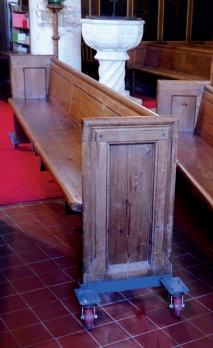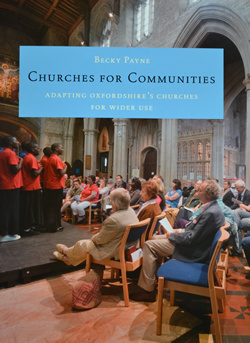Shared Space
Extending the Use of Churches in Oxfordshire
Becky Payne
 |
|
| St John the Baptist, Stadhampton with a small extension on the left which now provides village hall facilities (Photo: Mike Peckett) |
For a growing number of the UK’s churches, extending the use of the building beyond its traditional religious function is not only about community outreach, but also a question of survival. The combination of shrinking congregations and mounting maintenance costs is driving a wave of extensions and adaptations.
The successes and limitations of extended use are explored at a local level in Churches for Communities: Adapting Oxfordshire’s Churches for Wider Use. Commissioned by the Rt Revd Colin Fletcher, Bishop of Dorchester and by the Oxfordshire Historic Churches Trust in 2012, the book’s remit was to describe the changes that have taken place in Oxfordshire’s places of worship over the last 30 years. The focus was on projects where the main objectives were to meet modern worship needs and open up spaces for wider community use.
Published in February 2014, the book records the stories of the incumbents, architects and particularly the many volunteers who, as members of parochial church councils (PCCs) or building project and fundraising committees, worked tirelessly to bring their visions to fruition. Importantly, it also provides inspiration and advice for others who might be considering taking up the challenge.
As a result, 25 projects were chosen which would be described from conception to completion and examined in terms of their contribution to the long-term viability of the building. Participants were asked about their vision, how they engaged with the community, raised funds, negotiated with church authorities and conservation bodies, what challenges they faced and what lessons were learned.
From varied backgrounds, most of the people responsible for driving these projects forward were embarking for the first time on a complex journey that involved a place of worship, a historic building and a community project all in one. All got involved out of a genuine wish to reconnect the building with its local community and with a recognition that the building would not survive as a living place of worship if it remained under-used. Many of the churches involved were struggling to cope with expensive repair bills and declining congregations. The key was recognising that a sustainable solution had to be communitybased, rather than purely built around the needs of worship. It was clear that even if a congregation was prepared to endure a cold and damp building with no facilities, it was unlikely that community groups would.
The objectives may have been similar in all 25 projects, but they did not result in uniform solutions. As well as the legal constraints that control changes to listed ecclesiastical buildings, a range of other factors determined the final outcome. These include local circumstances, the current viability of the building and its congregation, and the preferences of the congregation and local community.
 |
 |
||
| St John the Evangelist, Fernham which now functions as both church and village hall: (left) the view towards the east end with all the pews removed, and (right) the new facilities at the west end | |||
COMMUNITY CONSULTATION
Consulting with the wider community is essential to identifying how a church can help meet a community need. Most of the projects asked the community what they would like to use the church for and presented draft proposals for the installation of new facilities and the creation of community space. While managing the responses was relatively straightforward for some churches, it was a major challenge for others.
At Fernham, a village of about 250 with no existing community space, church services at St John the Evangelist (Grade II) were attracting a small, elderly congregation and the PCC was concerned about maintenance costs. The roof was beginning to leak and the building was cold and damp. Fully pewed, it could not be used for much beyond services, concerts and film nights. In 2002 the churchwarden circulated a survey stating that the congregation would be unable to sustain the church as it was and asking whether there were objections to adapting it. The survey achieved a 50 per cent response rate, with the overwhelming majority in favour of adapting the building into a combined church and village hall (illustrated opposite).
Stadhampton had not had a village hall since the 1960s. St John the Baptist (Grade II) was isolated and, while in good repair, it had no mains water or drainage. With diminishing congregation numbers, it stood empty for six days a week. The PCC welcomed an approach from Stadhampton Community Building Project Committee, which had been set up to address the lack of a village hall, to discuss a joint venture. Two representatives from the PCC and the incumbent joined the project committee. A consultation revealed that 89 per cent of respondents wanted a village hall, but identified two options: building a new hall or adapting the church. The cost of a new build was found to be prohibitive and it was recognised that modifying the church would preserve a much-loved historic building which had been ‘at the heart of the community for over 900 years’.
In other cases, a lot of work had to be done to bring people on side when major changes were being proposed to a sacred place, loved by its community – even if some rarely crossed the threshold. Change challenges many people’s expectations of what a church should look like and PCCs faced genuine concerns and in a very few cases, hostility. This could come from within the PCC itself, from the congregation or very often from the wider community. Many community members saw pews as essential to the spiritual atmosphere of the building. Some feared that the church would turn into an ‘entertainment centre’, or that installing a toilet would compromise its essential mystery.
 |
|
| St Nicholas, Chadlington: the new meeting room in the north transept and the 12 retained pews (All photos by the author unless otherwise stated) |
In a small community, any discord can be painful. Churchwardens and incumbents listened, talked things through, arranged visits to other projects and amended proposals. Some, faced with high bills and possible closure, felt they had to take a decision even if, at times, it felt a lonely one.
There can also be a difficulty in visualising what the resulting building will look like, especially for those not used to looking at plans. Changes to fittings and furnishings can also have unforeseen impacts on the appearance and atmosphere of the space.
For example, at St Nicholas, Chadlington (Grade II*), the intention was to retain all the pews in line with the strong local opposition to a proposal to replace them with a more flexible seating system. However, when members of the PCC visited the church between the completion of the underfloor heating installation and the new floor being laid, there was a surprising change of heart.
According to the Revd Mark Abrey, ‘the two members of the PCC who had been most adamant that the pews must be retained came and said that, actually, the space looks so beautiful, can we just put back six pews each side of the centre of the nave?’ This was agreed, and the 12 pews, which are now movable, can seat some 70 members of the congregation, more than sufficient for a Sunday service. For larger services and other events, additional seating is provided by new folding chairs.
NEGOTIATING PERMISSION
While understanding the need for the Church of England’s faculty system (which regulates proposed changes to church buildings and their contents), many groups felt that negotiating alterations and the location of new facilities took too long. Some found it extremely frustrating that they were prevented from making what they saw as essential changes. To them it was ‘illogical’ that in a church that had been reordered every century since the 1300s, they were being prevented from implementing their vision.
The most common area of conflict between a church and the diocesan advisory committee (DAC) or amenity society (1) was the removal of what a church would describe as a standard set of mid-Victorian pews or the wish to move a font or pulpit. For an amenity society, moving the lectern two feet to the north would remove it from its historical context, while for the project committee, it was key to being able to install a stage. But there was also praise for the DAC, English Heritage and other experts whose advice often unlocked previously insoluble problems.
 |
|
| St Mary the Virgin, Chalgrove: a pew being moved using the specially designed pew skate (Photo: Robert Heath-Whyte) |
The 25 churches described in Churches for Communities illustrate a range of solutions in terms of their physical transformations. The projects ranged in cost from £100,000 to over £1 million and from major re-orderings of the interior to housing new facilities in an extension to fitting the new facilities in the base of a tower or at the end of an aisle.
Some churches, often those which had been sub-divided in the 1970s or 1980s, wished to return to a single architectural space, while others wanted to create enclosed zones. Many kept their pews or retained at least half of them. Some argued that pews are still the most efficient way to seat a whole school, for example.
St Thomas of Canterbury, Elsfield, (Grade II*), is a small church in a village of 100 people with no community facilities. The church held one service a month and was at risk of closure until it was decided that it could provide a much-needed village asset.
In 2002, the west end was cleared of pews to create a ‘village room’, separated from the nave by a folding oak and glass screen. The toilet, kitchen and storage area were housed in a new extension leading off the village room. The rest of the nave and chancel remained unchanged and the retained pews in the nave can seat about 40 people, sufficient for the congregation. The sign outside the church now proudly states ‘Church of St Thomas of Canterbury and Elsfield Village Room’.
At St Mary the Virgin, Chalgrove (Grade I), it was decided to locate the facilities at the base of the west tower so that the spiritual atmosphere and unity of nave and chancel is retained. The pine pews, although unremarkable, have been repaired and retained. With the help of two ‘pew skates’ (above left), designed by a member of the congregation, the pews can be removed for special events. They are normally placed at an angle so that everyone can see more easily.
‘There is a sense of being “in the round” which has enhanced the worship,’ says the Revd Canon Ian Cohen. ‘For this church, pews are still important and at weddings and funerals, people want to sit on pews and feel close to each other.’
In 2012, an extension was built onto St Agatha’s (Grade II*), Brightwell-cum-Sotwell, to serve as a multi-function room with a servery. Access is through the church’s south door into a porch-style link which houses two toilets. The church remains otherwise unchanged, reflecting the PCC’s wish to retain the internal architectural space. There was also a fear that a re-ordering ‘would perhaps cause such division within the community that we would never achieve resolution’.
At St Edburg’s, Bicester (Grade I), the pews were removed. The Victorian Society initially resisted but changed its mind after the PCC asked it to visit. Once its caseworker had seen the poor-quality 1860s pine bench pews and the presence of woodworm, the Victorian Society agreed to the removal of the pews on condition that the 1863 stone pulpit remained in its original position.
SHARING SACRED AND COMMUNITY SPACE
Another common challenge was managing a building now used for both worship and community activities. Even those who believe in creating a building that is both an active place of worship and a shared space that welcomes all can find the reality a bit of a shock.
As one vicar explained, ‘People wanted to use it for non-religious purposes and that is great, but it does lead to some complexity’. If a church raises all the money, it can regulate the usage but if the plan is to go into partnership with the wider community, having asked for their views and having taken their money then, as another vicar said, ‘You have to be very sure that your vision for the new building encompasses the new ways in which it will be used’.
 |
|
| The case studies discussed in this article can be read in full in Becky Payne’s Churches for Communities: Adapting Oxfordshire’s Churches for Wider Use, published by the Oxfordshire Historic Churches Trust (February 2014). All proceeds go to the work of the trust. Copies can be purchased online. |
One issue that is often not completely resolved is how to retain a quiet space for reflection when other activities are taking place. Often the chancel is identified as that space, or in other cases separate soundproofed spaces have been created for noisy activities such as the toddlers’ group, but in some cases, for a lot of the time, that quiet space has been lost.
However, inviting new people to use the building means there are additional people to look after it. New models of managing the churches are emerging which may provide a key to the sustainability of others.
At St Thomas’, Elsfield, the village room is managed by a committee made up of church members and non-churchgoing residents. They raise funds to cover its running and maintenance costs, currently £4,000 a year.
St John the Evangelist, Fernham, is now managed under a 30-year repairing lease from the diocese by the Fernham Village Trust, which has responsibility for routine maintenance. The PCC pays to hire it for services and other church activities such as weddings and funerals. The lease states that the trust will pay 60 per cent of the cost of any necessary major works while the PCC will contribute 40 per cent, reflecting the split between chancel and nave.
Neil Sutherland, chair of the project group, says ‘It is still a delightful village church and when there is a service, the only visible change is that the font has moved and there are more comfortable chairs. Prior to the conversion it was half a story; now it has become a focus of the community’.
In October 2013, St John the Baptist, Stadhampton, reopened as the church and village hall following a major internal re-ordering. An interim management committee manages day-to-day issues while working out how a partnership model of management will operate.
Many projects report positive outcomes including:
- an increase in footfall and income
- new people joining the congregation
- a stronger relationship with nonchurchgoers
- increased community harmony
- an increase in the number of people who value the church and will help to maintain it.
Some are also finding that their new building is not being used as much as they had hoped and are learning how to market it more effectively. Others are still uncertain about whether increased use is going to bring in sufficient income to help sustain the building in the long term. Managing daily activities means that running costs and administrative workloads increase. Setting up before and clearing up after different activities can also be time-consuming.
Further research is needed to find out how we can measure what these projects are delivering and whether they are providing sustainability for the building and congregation over the longer term. Knowing more about the potential benefits of opening up their church while being aware of what outcomes it is reasonable to expect will help the organisers of future projects to take the necessary steps to maximise their success.
~~~
Notes
(1) In England the national amenity societies are: the Ancient Monuments Society, the Council for British Archaeology, the Society for the Protection of Ancient Buildings, the Georgian Group, the Victorian Society and the 20th Century Society. As well as English Heritage, the relevant amenity society/-ies must be notified when works are proposed to a listed church.



